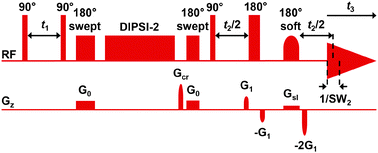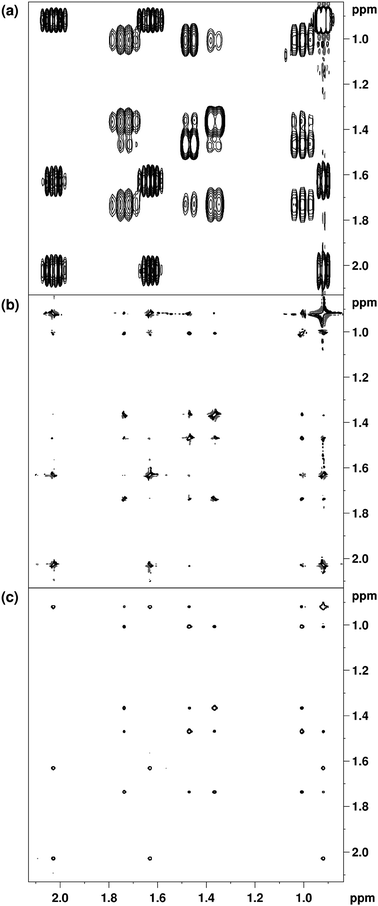Zero-quantum filtered pure shift TOCSY†
Jari J.
Koivisto
*
Department of Chemistry, Aalto University School of Chemical Technology, P.O. Box 16100, 00076, Finland. E-mail: jari.koivisto@aalto.fi; Tel: +358 50 3438574
First published on 14th November 2012
Abstract
The high spectral resolution provided by the pure shift TOCSY experiment can be significantly improved by zero-quantum filtering which eliminates dispersive anti-phase contributions from the spectrum.
The 2D TOCSY experiment is a homonuclear NMR technique that is widely used to identify proton–proton correlations within networks of J-coupled spins. This experiment is especially useful in the analysis of the chemical structure of peptides, proteins, oligosaccharides and polysaccharides. TOCSY also has many applications in the structural elucidation of smaller molecules. Although homonuclear couplings are fundamental to the TOCSY experiment, the multiplet structure these couplings cause can severely degrade the spectral resolution. The TOCSY spectrum can be simplified and its resolution can be improved by collapsing all multiplets to singlets. In the resulting pure shift TOCSY spectrum,1 a single peak is seen for each coupling relationship.
Another factor that can reduce the resolution and overall quality of the TOCSY spectrum is zero-quantum coherence generated during the TOCSY pulse sequence. Typically, the effects of zero-quantum coherence are seen as phase distortions on both the cross and diagonal peaks in the spectrum. Therefore, to obtain a TOCSY spectrum with a pure phase, it is necessary to eliminate these dispersive anti-phase contributions by a suitable means. One of the most efficient methods of zero-quantum suppression involves applying simultaneously a swept-frequency 180° pulse and a gradient.2 Here, this combination is introduced into the pure shift TOCSY pulse sequence, demonstrating that the already high resolution of the pure shift TOCSY spectrum can be substantially improved by eliminating unwanted zero-quantum interferences.
The pulse sequence for acquiring zero-quantum filtered (ZQF) pure shift TOCSY is shown in Fig. 1. The DIPSI-2 sequence is used for isotropic mixing. The ZQF element consisting of the swept-pulse/gradient pair is introduced before and after the DIPSI-2 block, as suggested by Thrippleton and Keeler.2 The pure shift part of the sequence is based on the experiment of Zangger and Sterk (ZS).3 Here, the improved version of the original ZS experiment is employed.4 In addition to the ZQF pure shift TOCSY experiments, the pure shift TOCSY experiments without zero-quantum suppression and the conventional ZQF TOCSY experiments were also performed. The pure shift TOCSY pulse sequence without zero-quantum filtering is shown in Fig. S1a in the ESI.† Both ZQF elements and the crusher gradient Gcr after the DIPSI-2 block are omitted from this sequence. Otherwise, the two pure shift pulse sequences are identical. The pulse sequence for the conventional ZQF TOCSY experiment is shown in Fig. S1b in the ESI.†
 | ||
| Fig. 1 Pulse sequence for the ZQF pure shift TOCSY experiment. The details of the pulse sequence are described in the ESI.† | ||
The production of the pure shift TOCSY spectrum consists of three steps. First, a 3D data set is acquired. Second, a reconstruction program‡ is used to generate a 2D data set in which the F2 dimension is decoupled. Third, covariance processing5,6 is applied to produce a fully decoupled 2D TOCSY spectrum. Fig. 2 shows a comparison between the conventional ZQF TOCSY spectrum (Fig. 2a) and the pure shift TOCSY spectra acquired without (Fig. 2b) and with (Fig. 2c) zero-quantum suppression. The same region of the spectrum of (−)-eburnamonine is shown in each case. All spectra were acquired using a 20 ms DIPSI-2 mixing sequence. A short mixing time was used, because under these conditions the dispersive anti-phase contributions arising from zero-quantum coherence are most apparent and problematic.
 | ||
| Fig. 2 Conventional ZQF TOCSY spectrum (a) and the pure shift TOCSY spectra acquired without (b) and with (c) zero-quantum filtering. The same region of the spectrum of (−)-eburnamonine is shown in each case. All spectra were acquired using a 20 ms DIPSI-2 mixing sequence. The intensities of the peaks in the pure shift spectra in b and c are adjusted exactly to the same level. The full spectra are shown in the ESI.† | ||
When comparing the spectra in Fig. 2a and b, it is clear that the resolution of the TOCSY experiment can be dramatically improved by collapsing all multiplets to singlets. However, most of the cross and diagonal peaks in the pure shift TOCSY spectrum shown in Fig. 2b suffer from phase distortions caused by zero-quantum contributions. Therefore, the resolution of this spectrum is far from optimal. In contrast, all cross and diagonal peaks in the ZQF pure shift TOCSY spectrum shown in Fig. 2c are in-phase and have absorption-mode line shapes. Consequently, the ZQF pure shift TOCSY pulse sequence given in Fig. 1 produces a spectrum with greatly increased resolution when compared with the spectrum produced by the pure shift TOCSY sequence without the ZQF elements (Fig. S1a, ESI†). In addition to the phase distortions and reduced resolution, zero-quantum interferences may have another deleterious effect: it has been reported that in some cases collapsing the anti-phase multiplet structure of the cross peak may cause the signal to disappear from the pure shift TOCSY spectrum.1 It is likely that the disappearance of the anti-phase cross peak occurs when it consists of approximately equal amounts of positive and negative contributions (i.e. when its total integral is close to zero). This type of multiplet is potentially collapsed to zero by the decoupling. In the ZQF pure shift TOCSY pulse sequence, the anti-phase contributions are removed before the multiplets are collapsed to singlets. Therefore, it is highly unlikely that the cross peaks disappear from the ZQF pure shift TOCSY spectrum. Consequently, the ZQF pure shift TOCSY experiment provides more reliable data than the non-ZQF version of this experiment.
The ZQF pure shift TOCSY experiment has two disadvantages. First, like all 2D pure shift experiments based on the ZS method, it has low sensitivity. Therefore, the acquisition time for this experiment can be relatively long. Fortunately, the acquisition of multi-dimensional pure shift data can be greatly accelerated using Non-Uniform Sampling (NUS) techniques. Second, strong coupling often leads to additional responses, commonly at frequencies between the two coupled chemical shifts. The ZS part of the pulse sequence may be replaced by the bilinear rotation decoupling (BIRD) element if strong coupling causes problems in spectral assignment.7,8
In conclusion, the already high resolution of the pure shift TOCSY spectrum can be substantially improved by suppressing undesirable dispersive anti-phase contributions arising from zero-quantum coherence. In addition, because in the ZQF pure shift TOCSY pulse sequence the anti-phase contributions are removed before the decoupling occurs, it is highly unlikely that the multiplets are collapsed to zero by the decoupling. Consequently, the ZQF pure shift TOCSY experiment could help significantly in NMR spectral and structural analysis of complex molecules and systems.
The author would like to thank Professor Emeritus Erkki Kolehmainen (University of Jyväskylä, Finland) for helpful discussions and valuable suggestions.
Notes and references
- G. A. Morris, J. A. Aguilar, R. Evans, S. Haiber and M. Nilsson, J. Am. Chem. Soc., 2010, 132, 12770–12772 CrossRef CAS.
- M. J. Thrippleton and J. Keeler, Angew. Chem., Int. Ed., 2003, 42, 3938–3941 CrossRef CAS.
- K. Zangger and H. Sterk, J. Magn. Reson., 1997, 124, 486–489 CrossRef CAS.
- J. A. Aguilar, S. Faulkner, M. Nilsson and G. A. Morris, Angew. Chem., Int. Ed., 2010, 49, 3901–3903 CrossRef CAS.
- R. Brüschweiler and F. Zhang, J. Chem. Phys., 2004, 120, 5253–5260 CrossRef.
- N. Trbovic, S. Smirnov, F. Zhang and R. Brüschweiler, J. Magn. Reson., 2004, 171, 277–283 CrossRef CAS.
- J. A. Aguilar, M. Nilsson and G. A. Morris, Angew. Chem., Int. Ed., 2011, 50, 9716–9717 CrossRef CAS.
- J. A. Aguilar, A. A. Colbourne, J. Cassani, M. Nilsson and G. A. Morris, Angew. Chem., Int. Ed., 2012, 51, 6460–6463 CrossRef CAS.
Footnotes |
| † Electronic supplementary information (ESI) available: Experimental details. Molecular structure of (−)-eburnamonine. Pulse sequence timing diagrams for the non-ZQF pure shift TOCSY and conventional ZQF TOCSY experiments. Full conventional and pure shift TOCSY spectra. Pulse sequence for the ZQF pure shift TOCSY experiment (Bruker spectrometers). See DOI: 10.1039/c2cc37461g |
| ‡ A. Moreno and R. Adams, the Bruker AU program “pshift”. The original version of this reconstruction program was modified by the author to cope with the aqseq 321 data (the original program was written for the aqseq 312 data). In Bruker pulse programs, the acquisition status parameter AQSEQ describes the order in which the 1D FID's of a 3D acquisition are written into the file (3 = the acquisition dimension, 1 and 2 = the orthogonal dimensions). The modified reconstruction program is available from the author by request. |
| This journal is © The Royal Society of Chemistry 2013 |
